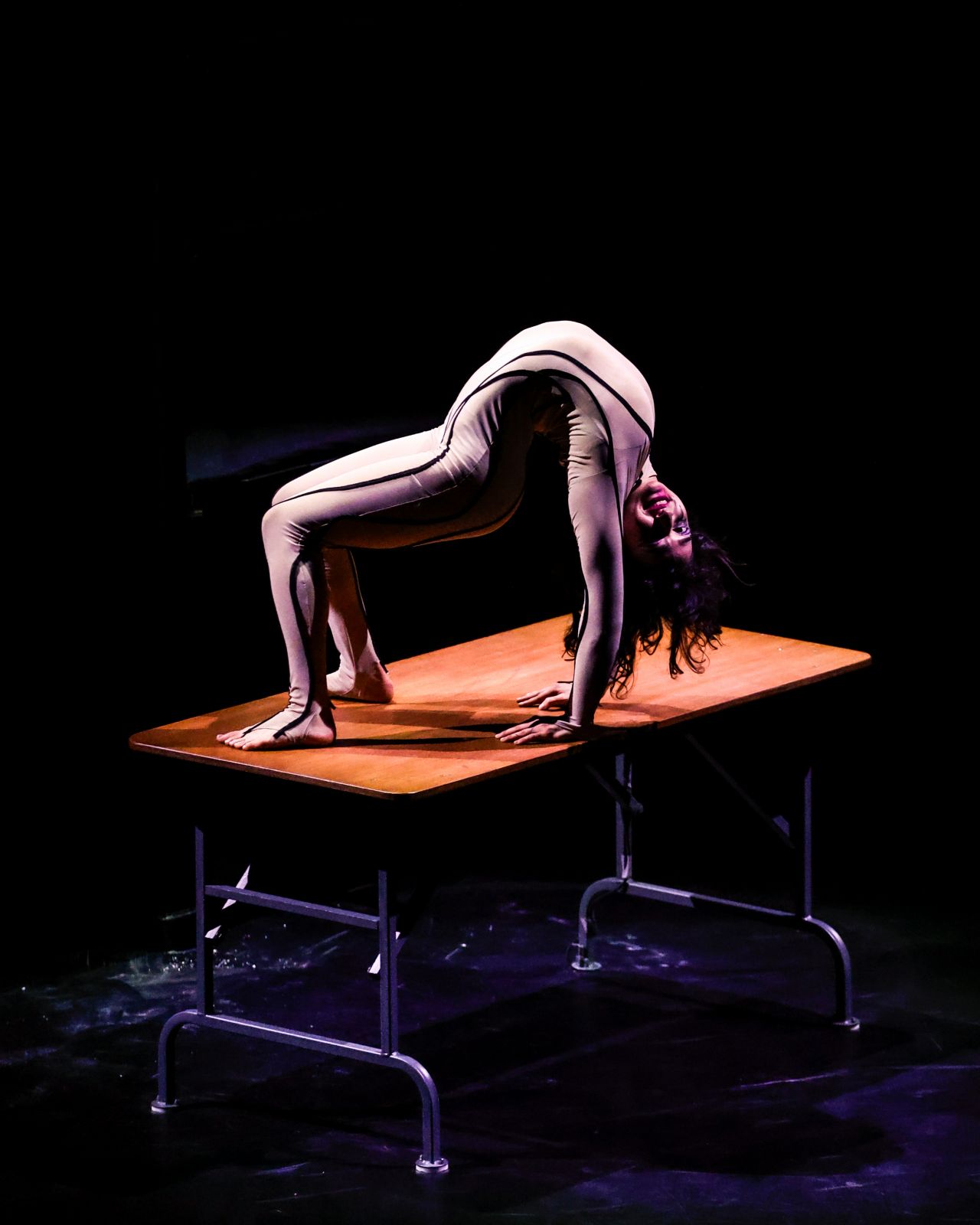October 29, 2024
Contortionist and Philadelphia native Naomi Eddy finds a fit in Flip Fabrique’s ‘SLAM!’

”For the performers, it’s so much more fun when the audience is really vocal. So, when you come to watch, you can scream, you can boo, you can yell, whatever you want,” said Flip Fabrique acrobat Naomi Eddy.
Credit: JFSavariaBy Alex Fischer
By day, Naomi Eddy is a cirque contortionist based in Québec City. And by Wednesday night, Eddy will portray a groupie girl, a Barbie cowgirl fighter, half-humanoid-half-bug, and a wild cat in a tournament-style, alt-circus performance.
The Philadelphia native will join Flip Fabrique and Ex Machina for their theatrical circus wrestling production “SLAM!” The contemporary cirque returns to Penn State for the performance at 7:30 p.m. Wednesday, Oct. 30, in Eisenhower Auditorium.
“SLAM!” is a very theatrical circus show. It’s kind of based on the World Wresting Entertainment-like wrestling tournament,” Eddy said. They spoke with the Center for the Performing Arts about their enthusiasm for the Marinelli Bend and being yelled at, and no, contortion doesn’t hurt.
Alex Fischer: What got you into contortion and circus performing?
Naomi Eddy: Both of my parents are jugglers, so I always grew up around the circus and going to juggling clubs, and seeing little festivals and shows. And I was always naturally flexible in my lower back, very specifically in, like, two vertebrae. So, I was always bending my whole life, but I didn't start circus until 2016, and I was super lucky because my parents’ friends actually opened the Philadelphia School of Circus Arts and had a contortion class. So, I took it and it worked really well for me, and I just kind of fell in love with the community and the art form, and I stuck with it.
Q: What is the Marinelli Bend? How long did it take, and how were you able to achieve doing it?
A: The Marinelli Bend [is] more commonly known as mouthpiece … I can do a trick where I bite down on a mouthpiece that’s connected to kind of like a cane into a base. And I fold over, so essentially, I sit on my head, and my feet are off the ground. And then I engage, and I can lift my arms so that all of my balance is just like, on my mouth, and I’m balancing on my head and nothing is on the ground.
This trick, I entirely learned from my coach, Erdenesuvd. Erdenesuvd and Buyankhishig Ganbaatar, they’re contortion sisters, they’re really masters at their craft. They’re from Mongolia, they’ve been performing for over 20 years, they know how to take care of their bodies. And this trick, I asked Erdenesuvd if it would be possible to learn. And she was so enthusiastic. She helped me get the apparatus, and the skill took, I think, around four months to get … stage ready. And yeah, it's just an incredible feeling, like nothing is on the ground, you know, it feels like I’m flying.
Q: What inspires your contortion routines?
A: I like to take from a lot of different things. I like to find what works for me and what I like aesthetically, and pick and choose, and then begin to create, kind of like my own portfolio, of what I like to do. I think that’s a lot of the creative process and inspiration into how I create numbers, and just pulling from everything that I like. … You can kind of create something “new,” you know, just new things that have already been done.
Q: You mentioned getting asked if contorting hurts. Is that something you get asked a lot as a contortionist?
A: Yes, all the time. So the answer is no, but as long as you have a good technique and a good warm up. With contortion. specifically with the back, it's really fragile. And to have a good warmup is so important for contortion. Like, I think contorting without warmup is impossible. And that's why, like, contortion can be painful, but usually it's because the person isn't warming up properly. So for me, it's so important in the show that I do my hour and a half warmup before and my cooldown after. And along with that, I also do training after the show so that my body can be really physically strong and support the natural flexibility that I have. If I don't do all of these things in that order, I can have pain and it can be, like, pain that lingers for a long time. So the answer to that is no, contortion should not hurt if you’re doing it properly.

“SLAM!” is a hyper-theatre spectacle where acrobats portray a cast of characters, heroes and villains.
Credit: JFSavariaQ: What advice do you have for any aspiring professional contortionists or circus artists like yourself?
A: I think my advice for aspiring circus artists would be: one, to take care of your body mentally and physically, because our whole job is our bodies, and it’s so important to remain healthy so you can have a long, sustainable career. … And also, I think to really try to remain passionate and love what you do, because also as a circus artist, you know, it’s not all fun on stage. It’s a lot and a lot of hard work. And, you know, to remain healthy mentally and physically, I think it’s really important that you can keep passion and keep your understanding of why you do circus.
Call the Arts Ticket Center at 814-863-0255 or visit Flip Fabrique online for more information and to purchase tickets.
Alex Fischer is a communications intern for the Center for the Performing Arts.
Ex Machina and FLIP Fabrique would like to thank the Canada Council for the Arts, the Conseil des arts et des lettres du Québec, and the City of Quebec for their financial support.